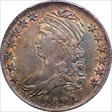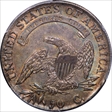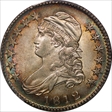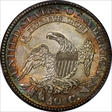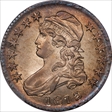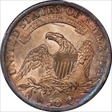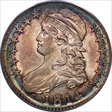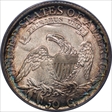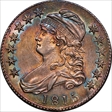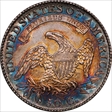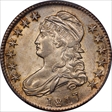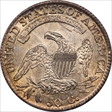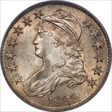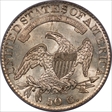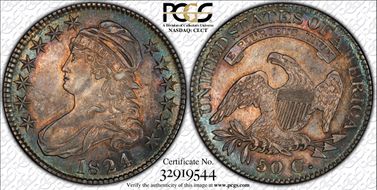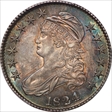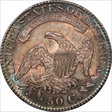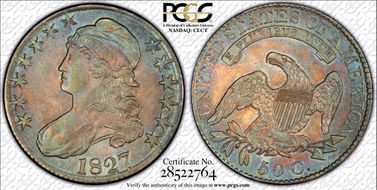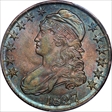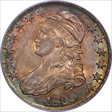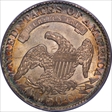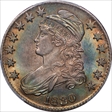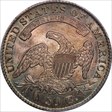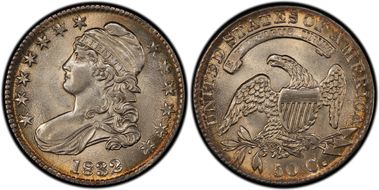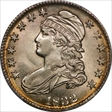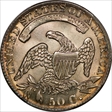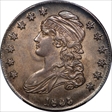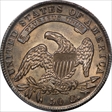Keigwin 的钱币相册
O.112, R1. CAC. The misnamed 50/20 variety...the 2 underneath the 5 in the denomination is really just an upside down 5! The example has lovely album toning with blue and gold rims and orange and grey centers. Nicely struck with pleasant surfaces and no distractions.
O.112, R1. CAC. The misnamed 50/20 variety...the 2 underneath the 5 in the denomination is really just an upside down 5! The example has lovely album toning with blue and gold rims and orange and grey centers. Nicely struck with pleasant surfaces and no distractions.
O.101, R1. CAC. Ex-Davignon. Hammered! Sheridan Downey's catalog description: Ex Gerald Schertz. The surfaces, while virtually free of contact marks, feature a wonderful morass of die breaks and clash marks. Only a peacock might aspire to the range of iridescent colors that grab and hold the viewer’s eye. Keith purchased the coin from me in June 1994; it was part of the nearly complete die variety set of Dr. Gerald Schertz, BHNC #45.
O.101, R1. CAC. Ex-Davignon. Hammered! Sheridan Downey's catalog description: Ex Gerald Schertz. The surfaces, while virtually free of contact marks, feature a wonderful morass of die breaks and clash marks. Only a peacock might aspire to the range of iridescent colors that grab and hold the viewer’s eye. Keith purchased the coin from me in June 1994; it was part of the nearly complete die variety set of Dr. Gerald Schertz, BHNC #45.
O.105, R1. CAC. ex-David Kahn. Catalog description: Fully struck obverse. All 13 stars display center points. The reverse is comparable, with slight weakness at top of left wing. Cartwheel luster rolls beneath the medium grey antique toning. Here is a lovely 1809 for a top flight collection!
O.105, R1. CAC. ex-David Kahn. Catalog description: Fully struck obverse. All 13 stars display center points. The reverse is comparable, with slight weakness at top of left wing. Cartwheel luster rolls beneath the medium grey antique toning. Here is a lovely 1809 for a top flight collection!
O.103a, R4. Exotic is a great way to describe the look and appeal of this somewhat scarce die marriage. Intense, deep chocolate brown dominates the obverse, blending into sea green rims. Mauve paints the reverse yielding to more blue/green. Nice luster flashes underneath all this, spewing splashy iridescence as the coin is rotated in hand. Clashing enthusiasts will love the crisp impression of eagle on the obverse with the rare appearance of leaves and berries at Liberty's forehead and arrowheads atop her cap. Signs of die erosion and fatigue are obvious on each side with significant die cracks at 1811 and 50 C. In spite of the LDS a good strike produces full details (curls, clasp, banner, feathers) with only a touch of weakness at TA and the upper left wing. ex-Pittman, lot 1459
O.103a, R4. Exotic is a great way to describe the look and appeal of this somewhat scarce die marriage. Intense, deep chocolate brown dominates the obverse, blending into sea green rims. Mauve paints the reverse yielding to more blue/green. Nice luster flashes underneath all this, spewing splashy iridescence as the coin is rotated in hand. Clashing enthusiasts will love the crisp impression of eagle on the obverse with the rare appearance of leaves and berries at Liberty's forehead and arrowheads atop her cap. Signs of die erosion and fatigue are obvious on each side with significant die cracks at 1811 and 50 C. In spite of the LDS a good strike produces full details (curls, clasp, banner, feathers) with only a touch of weakness at TA and the upper left wing. ex-Pittman, lot 1459
O.108a R2. CAC. Ten marriages for 1813, more than 1.2 million minted, most with weak-to-good strike. This version is a favorite. Formerly owned by Prouty (as a MS62), and more recently by the late Roger Solomon. It is simply superb: a sharply impressed EDS obverse is paired with a well used but nicely struck reverse. The die pair produced halves with very weak milling...often incomplete. Overton states: Many specimens show rim damage in minting, especially on the reverse and adjacent to AMERICA. The 108a die state is more common than the 108 R4. Obverse die cracks and incomplete reverse milling characterize it. Color is attractive silver and gold with a bit of burnt orange. Surfaces are all but mark free, save some Mint clashing. The luster is remarkably full and strong. Only the very slightest rub can be seen at upper left wing.
O.108a R2. CAC. Ten marriages for 1813, more than 1.2 million minted, most with weak-to-good strike. This version is a favorite. Formerly owned by Prouty (as a MS62), and more recently by the late Roger Solomon. It is simply superb: a sharply impressed EDS obverse is paired with a well used but nicely struck reverse. The die pair produced halves with very weak milling...often incomplete. Overton states: Many specimens show rim damage in minting, especially on the reverse and adjacent to AMERICA. The 108a die state is more common than the 108 R4. Obverse die cracks and incomplete reverse milling characterize it. Color is attractive silver and gold with a bit of burnt orange. Surfaces are all but mark free, save some Mint clashing. The luster is remarkably full and strong. Only the very slightest rub can be seen at upper left wing.
O.102a, R3. 1814 is a very fun year for CBH enthusiasts. Nine die marriages were produced from a mintage of just over 1 million, the fourth lowest of the series. Among these nine marriages of this historically important year were the 1814/3 overdate (Overton 101), the very scarce single leaf (Overton 105a) and the major variety E over A (Overton 108).
O.102a, R3. 1814 is a very fun year for CBH enthusiasts. Nine die marriages were produced from a mintage of just over 1 million, the fourth lowest of the series. Among these nine marriages of this historically important year were the 1814/3 overdate (Overton 101), the very scarce single leaf (Overton 105a) and the major variety E over A (Overton 108).
O.101, R2. CAC. From the George Hamilton collection, lot 4093. Originally housed in an NGC old fattie graded AU55 with a CAC gold sticker. The catalog description: It is challenging to find an 1815/2 half dollar with any degree of eye appeal. They are by and large a dull lot, and many of the surviving pieces are impaired in one way or another. The present coin is a wonderful exception. Originally toned in attractive blue, violet, and tangerine-gold toning, both sides are brightly lustrous and sharply struck. Aside from the inevitable die clashing, there are no marks of consequence. Housed in an early generation NGC holder from about 25 years ago (with hologram but without the barcode), this Choice About Uncirculated coin carries the CAC gold sticker indicating it is undergraded by at least one level. An interesting bit of trivia about the 1815/2 is that the entire lot of coins struck in early Jan 1816 were paid out to a single customer: Jones, Firth and Co. How often can we trace provenance and know with certainty the original owner?
O.101, R2. CAC. From the George Hamilton collection, lot 4093. Originally housed in an NGC old fattie graded AU55 with a CAC gold sticker. The catalog description: It is challenging to find an 1815/2 half dollar with any degree of eye appeal. They are by and large a dull lot, and many of the surviving pieces are impaired in one way or another. The present coin is a wonderful exception. Originally toned in attractive blue, violet, and tangerine-gold toning, both sides are brightly lustrous and sharply struck. Aside from the inevitable die clashing, there are no marks of consequence. Housed in an early generation NGC holder from about 25 years ago (with hologram but without the barcode), this Choice About Uncirculated coin carries the CAC gold sticker indicating it is undergraded by at least one level. An interesting bit of trivia about the 1815/2 is that the entire lot of coins struck in early Jan 1816 were paid out to a single customer: Jones, Firth and Co. How often can we trace provenance and know with certainty the original owner?
O.101, R2. CAC. From the George Hamilton collection, lot 4093. Originally housed in an NGC old fattie graded AU55 with a CAC gold sticker. The catalog description: It is challenging to find an 1815/2 half dollar with any degree of eye appeal. They are by and large a dull lot, and many of the surviving pieces are impaired in one way or another. The present coin is a wonderful exception. Originally toned in attractive blue, violet, and tangerine-gold toning, both sides are brightly lustrous and sharply struck. Aside from the inevitable die clashing, there are no marks of consequence. Housed in an early generation NGC holder from about 25 years ago (with hologram but without the barcode), this Choice About Uncirculated coin carries the CAC gold sticker indicating it is undergraded by at least one level. An interesting bit of trivia about the 1815/2 is that the entire lot of coins struck in early Jan 1816 were paid out to a single customer: Jones, Firth and Co. How often can we trace provenance and know with certainty the original owner?
O.101, R2. CAC. From the George Hamilton collection, lot 4093. Originally housed in an NGC old fattie graded AU55 with a CAC gold sticker. The catalog description: It is challenging to find an 1815/2 half dollar with any degree of eye appeal. They are by and large a dull lot, and many of the surviving pieces are impaired in one way or another. The present coin is a wonderful exception. Originally toned in attractive blue, violet, and tangerine-gold toning, both sides are brightly lustrous and sharply struck. Aside from the inevitable die clashing, there are no marks of consequence. Housed in an early generation NGC holder from about 25 years ago (with hologram but without the barcode), this Choice About Uncirculated coin carries the CAC gold sticker indicating it is undergraded by at least one level. An interesting bit of trivia about the 1815/2 is that the entire lot of coins struck in early Jan 1816 were paid out to a single customer: Jones, Firth and Co. How often can we trace provenance and know with certainty the original owner?
O.112a, R2. For 1817 Chief Engraver Scot produced a new MD and struck new WH from which WD were made. Relief was somewhat lowered and central hair details were modified...thinner and more detailed, as were the folds in the cap. Liberty got a nose job, smaller and more attractive, and the relief of her cheek and jaw was improved. And yet not enough WD's were produced and the Mint had to rely on earlier ones, using an 1814 first (the ultra-rare 1817/4 variety), the obverse of which quickly broke after a handful of struck coins. The old 1813 die lasted longer, striking tens of thousands. For inspection, here is a pretty example from this tough year. This CBH has excellent luster with just a hint of toning at the periphery. An EDS obverse is paired with a shattered reverse giving this eye appealing coin nice character.
O.112a, R2. For 1817 Chief Engraver Scot produced a new MD and struck new WH from which WD were made. Relief was somewhat lowered and central hair details were modified...thinner and more detailed, as were the folds in the cap. Liberty got a nose job, smaller and more attractive, and the relief of her cheek and jaw was improved. And yet not enough WD's were produced and the Mint had to rely on earlier ones, using an 1814 first (the ultra-rare 1817/4 variety), the obverse of which quickly broke after a handful of struck coins. The old 1813 die lasted longer, striking tens of thousands. For inspection, here is a pretty example from this tough year. This CBH has excellent luster with just a hint of toning at the periphery. An EDS obverse is paired with a shattered reverse giving this eye appealing coin nice character.
O.101a, R1. The large 8 overdate is represented by two die marriages sharing the same obverse WD. O.101 and O.103. The underlying 7 show its ears at the top and the bar connecting them are clearly visible. Often part of the leg of the 7 appears in the loops below. A nice, clear overdate. The large 8 variety is scarcer than the small 8, with the O.103 being very scarce at the XF grade. This example possesses dazzling luster and vivid, colorful toning.
O.101a, R1. The large 8 overdate is represented by two die marriages sharing the same obverse WD. O.101 and O.103. The underlying 7 show its ears at the top and the bar connecting them are clearly visible. Often part of the leg of the 7 appears in the loops below. A nice, clear overdate. The large 8 variety is scarcer than the small 8, with the O.103 being very scarce at the XF grade. This example possesses dazzling luster and vivid, colorful toning.
O.101a, R1. The large 8 overdate is represented by two die marriages sharing the same obverse WD. O.101 and O.103. The underlying 7 show its ears at the top and the bar connecting them are clearly visible. Often part of the leg of the 7 appears in the loops below. A nice, clear overdate. The large 8 variety is scarcer than the small 8, with the O.103 being very scarce at the XF grade. This example possesses dazzling luster and vivid, colorful toning.
O.113 R1. During 1819 the Mint struck a respectable 2.2 million half dollars using fifteen different die marriages. Five were overdates and ten, yeardates. This flashy yeardate is from the Dale Heisler collection and it's notable for its proof-like surfaces, EDS and full strike. A handsome gold album tone is present at the rims.
O.113 R1. During 1819 the Mint struck a respectable 2.2 million half dollars using fifteen different die marriages. Five were overdates and ten, yeardates. This flashy yeardate is from the Dale Heisler collection and it's notable for its proof-like surfaces, EDS and full strike. A handsome gold album tone is present at the rims.
O.108 R2. This is a very special variety from the Roger Solomon collection. It is a Class IV doubled die (offset hub doubling from centers misaligned). Not shelf doubling...true hub doubling. The reverse WD was slightly offset during its second hub impression, leaving visible doubling on the left wing, talons, claws, leaves, berries and arrow heads. Lovely sunburst rim toning is seen over flashy, clean surfaces, along with bountiful luster on an EDS, full denticles. An exceptional AU58.
O.108 R2. This is a very special variety from the Roger Solomon collection. It is a Class IV doubled die (offset hub doubling from centers misaligned). Not shelf doubling...true hub doubling. The reverse WD was slightly offset during its second hub impression, leaving visible doubling on the left wing, talons, claws, leaves, berries and arrow heads. Lovely sunburst rim toning is seen over flashy, clean surfaces, along with bountiful luster on an EDS, full denticles. An exceptional AU58.
O.105, R1. 1821 was marked by a small mintage (1.3 million pieces), likely smaller still as many were undoubtedly 1820's struck early in the year. Just 7 marriages resulted with no remarkable varieties. Most are well struck, as is this EDS example. When weak it was in predictable areas...center obverse, eagle's left wing, and banner. Experts believe the 1821 to be an undervalued sleeper and scarce at AU55 and above. This CBH, formerly a blue ANACS AU58 cert# 4162328), is a fully lustrous example with a thin ring of light album toning at the rims. It has more chatter from bag hits than I like, unfortunately.
O.105, R1. 1821 was marked by a small mintage (1.3 million pieces), likely smaller still as many were undoubtedly 1820's struck early in the year. Just 7 marriages resulted with no remarkable varieties. Most are well struck, as is this EDS example. When weak it was in predictable areas...center obverse, eagle's left wing, and banner. Experts believe the 1821 to be an undervalued sleeper and scarce at AU55 and above. This CBH, formerly a blue ANACS AU58 cert# 4162328), is a fully lustrous example with a thin ring of light album toning at the rims. It has more chatter from bag hits than I like, unfortunately.
O.112. R1. ex-CAC (PCGS cert 18101085). Tall 3 variety. Great surfaces, color, and luster. Only the faintest touch of cabinet friction. Link to auction: https://auctions.stacksbowers.com/lots/view/1-1NY35/1823-capped-bust-half-dollar-o-112-rarity-1-au-58-pcgs-cac
O.112. R1. ex-CAC (PCGS cert 18101085). Tall 3 variety. Great surfaces, color, and luster. Only the faintest touch of cabinet friction. Link to auction: https://auctions.stacksbowers.com/lots/view/1-1NY35/1823-capped-bust-half-dollar-o-112-rarity-1-au-58-pcgs-cac
O.108a, R1. NTS: regrade. This garden variety 1826 is a new favorite, purchased from a fellow-collector on the PCGS forum. It drips with eye appealing colors, surfaces and luster. The O.108a is no scarcer than its early die state O.108. It is identifiable by additional die cracks to both sides, about the date and lower obverse rim, and through UNITE and along the top of scroll to S2 on the reverse.
O.108a, R1. NTS: regrade. This garden variety 1826 is a new favorite, purchased from a fellow-collector on the PCGS forum. It drips with eye appealing colors, surfaces and luster. The O.108a is no scarcer than its early die state O.108. It is identifiable by additional die cracks to both sides, about the date and lower obverse rim, and through UNITE and along the top of scroll to S2 on the reverse.
O.122, R5. CAC. Cataloger's description: From the Dr. Charles Link collection, earlier in the Frederick collection, as noted on the PCGS label. Here is one of the 2 or 3 most important coins in the sale. Frederick’s 2x2 envelope accompanies. He wrote (in July 1980), “Easily the finest known of this very rare variety. Beautifully toned and choicely preserved, AU/AU+.” One uncirculated example has since surfaced, the De Olden PCGS MS 64, offered in MB 32, June 2006, lot 83, @$9,533. The Frederick/Link coin stays at #2 in the Condition Census, tied with the Meyer coin, also graded PCGS AU 58 (sold privately in July 2008 for $5,800). The toning on the current example is otherworldly! Preview is necessary. Any description will fall short, but must allude to the rose colored centers, surrounded by electric shades of turquoise and blue. Contact marks are absent. Cartwheel luster is undiminished in the fields. There is but a trace of friction on Liberty’s cheek.
O.122, R5. CAC. Cataloger's description: From the Dr. Charles Link collection, earlier in the Frederick collection, as noted on the PCGS label. Here is one of the 2 or 3 most important coins in the sale. Frederick’s 2x2 envelope accompanies. He wrote (in July 1980), “Easily the finest known of this very rare variety. Beautifully toned and choicely preserved, AU/AU+.” One uncirculated example has since surfaced, the De Olden PCGS MS 64, offered in MB 32, June 2006, lot 83, @$9,533. The Frederick/Link coin stays at #2 in the Condition Census, tied with the Meyer coin, also graded PCGS AU 58 (sold privately in July 2008 for $5,800). The toning on the current example is otherworldly! Preview is necessary. Any description will fall short, but must allude to the rose colored centers, surrounded by electric shades of turquoise and blue. Contact marks are absent. Cartwheel luster is undiminished in the fields. There is but a trace of friction on Liberty’s cheek.
O.122, R5. CAC. Cataloger's description: From the Dr. Charles Link collection, earlier in the Frederick collection, as noted on the PCGS label. Here is one of the 2 or 3 most important coins in the sale. Frederick’s 2x2 envelope accompanies. He wrote (in July 1980), “Easily the finest known of this very rare variety. Beautifully toned and choicely preserved, AU/AU+.” One uncirculated example has since surfaced, the De Olden PCGS MS 64, offered in MB 32, June 2006, lot 83, @$9,533. The Frederick/Link coin stays at #2 in the Condition Census, tied with the Meyer coin, also graded PCGS AU 58 (sold privately in July 2008 for $5,800). The toning on the current example is otherworldly! Preview is necessary. Any description will fall short, but must allude to the rose colored centers, surrounded by electric shades of turquoise and blue. Contact marks are absent. Cartwheel luster is undiminished in the fields. There is but a trace of friction on Liberty’s cheek.
O.107, R2. It would seem Kneass was terribly conflicted over the shape of the number 2. And the size and shape of 8. For during 1828 he experimented with a curled base 2, straight, with a top knob, without, large and small 8. Thank heaven he ultimately settled down. From 1832 onward it was all curl base, knob 2 and small 8. Ex-Willis, ex-Link.
O.107, R2. It would seem Kneass was terribly conflicted over the shape of the number 2. And the size and shape of 8. For during 1828 he experimented with a curled base 2, straight, with a top knob, without, large and small 8. Thank heaven he ultimately settled down. From 1832 onward it was all curl base, knob 2 and small 8. Ex-Willis, ex-Link.
O.115, R2. Cataloger's description: Eye appeal! Gorgeous rainbow toning blankets the pleasing surfaces. What’s not to like about this one?! Be sure to preview it in person. From the Cape Cod Collection.
O.115, R2. Cataloger's description: Eye appeal! Gorgeous rainbow toning blankets the pleasing surfaces. What’s not to like about this one?! Be sure to preview it in person. From the Cape Cod Collection.
O.111, R1. An unremarkable year notable mostly for changes to edge lettering. Some varieties (e.g., O.106, O.107) show doubling to LIBERTY. While this example is not either of those marriages it appears to show the same. Not hub doubling but the more common mechanical doubling, likely do to loose bolts on the screw press. This example looks to have spent many years in an album acquiring deeply colored rim toning. Unspoiled, undipped, original good looks with very clean fields. A wavy die crack joins the numerals at the base of the date and stripe one lines in shield merge and appear as two lines, not three.
O.111, R1. An unremarkable year notable mostly for changes to edge lettering. Some varieties (e.g., O.106, O.107) show doubling to LIBERTY. While this example is not either of those marriages it appears to show the same. Not hub doubling but the more common mechanical doubling, likely do to loose bolts on the screw press. This example looks to have spent many years in an album acquiring deeply colored rim toning. Unspoiled, undipped, original good looks with very clean fields. A wavy die crack joins the numerals at the base of the date and stripe one lines in shield merge and appear as two lines, not three.
O.111, R1. This variety is called the child's head for its whimsical, child-like appearance. Round, puffy cheeks, parted lips, and a wide-eyed look. It is also a nice example of an EDS with very clean fields and devices. The obverse appearance is a PL mirrored reflection, not cartwheel. Framed in pretty rose and burnt orange for an eye appealing appearance.
O.111, R1. This variety is called the child's head for its whimsical, child-like appearance. Round, puffy cheeks, parted lips, and a wide-eyed look. It is also a nice example of an EDS with very clean fields and devices. The obverse appearance is a PL mirrored reflection, not cartwheel. Framed in pretty rose and burnt orange for an eye appealing appearance.
O.101, R1. Dark gray & brown dirt with full, rolling luster, clean, smooth fields, deep, rich, original toning and just a bare hint of friction on the obverse only. No rub at all on the reverse. Ex-Jules Reiver (Heritage, January 2006 lot 23311 as NGC AU-58).
O.101, R1. Dark gray & brown dirt with full, rolling luster, clean, smooth fields, deep, rich, original toning and just a bare hint of friction on the obverse only. No rub at all on the reverse. Ex-Jules Reiver (Heritage, January 2006 lot 23311 as NGC AU-58).
O.114, R2. 1836 was a year of change for the Mint. At the most fundamental level screw presses were replaced with steam driven ones. For the bust half, edge lettering dies would be retired and closed collars introduced which produced reeded edges. A new design was crafted by Gobrecht, who was able to hub design elements, removing the laborious punching effort that produced so many lettered-edge varieties. It was a transitional year for the Mint and the half dollar, though. And the screw press produced, open collar stamped, working die punched, capped bust half dollar went out with a blaze of variety glory. Some of the popular ones include the 1836/1336, 50/00, bar dot, doubled clasp, beaded edge. We even got a small production of reeded-edge 1836 halves. This example is a very lustrous, handsomely toned AU58...one of the last lettered edge halves of its era.
O.114, R2. 1836 was a year of change for the Mint. At the most fundamental level screw presses were replaced with steam driven ones. For the bust half, edge lettering dies would be retired and closed collars introduced which produced reeded edges. A new design was crafted by Gobrecht, who was able to hub design elements, removing the laborious punching effort that produced so many lettered-edge varieties. It was a transitional year for the Mint and the half dollar, though. And the screw press produced, open collar stamped, working die punched, capped bust half dollar went out with a blaze of variety glory. Some of the popular ones include the 1836/1336, 50/00, bar dot, doubled clasp, beaded edge. We even got a small production of reeded-edge 1836 halves. This example is a very lustrous, handsomely toned AU58...one of the last lettered edge halves of its era.
GR-17 (JR-20), R1. One of the more common varieties and easily available. The obverse is normally well struck but the reverse, even in EDS, shows a significant die crack from 6 o'clock to 11. The reverse die in this example is counter clockwise rotated about 30 degrees. The half has remarkable, vivid toning emphasizing sea blue and green, soft magenta, and fiery orange.
GR-17 (JR-20), R1. One of the more common varieties and easily available. The obverse is normally well struck but the reverse, even in EDS, shows a significant die crack from 6 o'clock to 11. The reverse die in this example is counter clockwise rotated about 30 degrees. The half has remarkable, vivid toning emphasizing sea blue and green, soft magenta, and fiery orange.
GR-5, R2. A frosty, lustrous example of the last year in the series. Untoned and likely carefully dipped. Exceptional reverse strike and a weaker obverse. Some typical planchet roller marks but most subtle. (Was PCGS MS61, cert# 32919580)
GR-5, R2. A frosty, lustrous example of the last year in the series. Untoned and likely carefully dipped. Exceptional reverse strike and a weaker obverse. Some typical planchet roller marks but most subtle. (Was PCGS MS61, cert# 32919580)





































